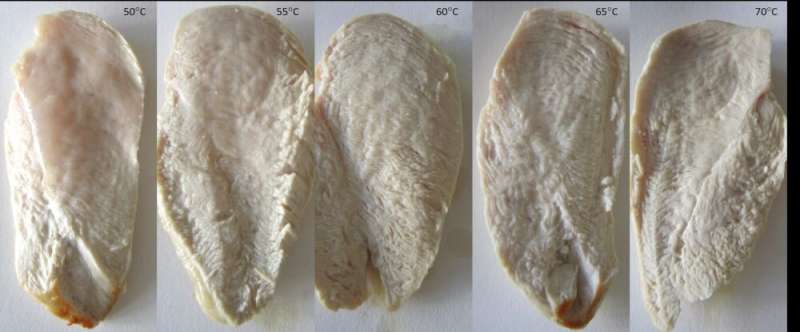Pictures of chicken fillets at different end temperatures (50-70°C). Credit: Langsrud et al, PLOS ONE, 2020 (CC BY)
For home cooks, widespread techniques for judging doneness of chicken may not ensure that pathogens are reduced to safe levels. Solveig Langsrud of the Norwegian Institute of Food, Fisheries and Aquaculture Research and colleagues present these findings in the open-access journal PLOS ONE on April 29, 2020.
Chicken can harbor the bacterial pathogens Salmonella and Campylobacter. High temperatures can kill these microbes, but enough may survive to cause illness if meat is undercooked. Recommendations for monitoring doneness vary widely, and the prevalence and safety of methods commonly used by home cooks have been unclear.
To help clarify consumers' chicken cooking practices, Lansgrud and colleagues surveyed 3,969 private households across five European countries (France, Norway, Portugal, Romania, and the U.K.) on their personal chicken cooking practices. They also interviewed and observed chicken cooking practices in 75 additional households in the same countries.
The analysis indicated that checking the inner color of chicken meat is a popular way to judge doneness, used by half of households. Other common methods include examining meat texture or juice color. However, the researchers also conducted laboratory experiments to test various techniques for judging doneness, and these demonstrated that color and texture are not reliable indicators of safety on their own: for example, the inner color of chicken changes at a temperature too low to sufficiently inactivate pathogens.
Food safety messages often recommend use of thermometers to judge doneness, but the researchers found that the surface of chicken meat may still harbor live pathogens after the inside is cooked sufficiently. Furthermore, thermometers are not widely used; only one of the 75 observed households employed one.
These findings suggest a need for updated recommendations that guarantee safety while accounting for consumers' habits and desire to avoid overcooked chicken. For now, the researchers recommend focusing on the color and texture of the thickest part of the meat, as well as ensuring that all surfaces reach sufficient temperatures.
"Consumers are often advised to use a food thermometer or check that the juices run clear to make sure that the chicken is cooked safely—we were surprised to find that these recommendations are not safe, not based on scientific evidence and rarely used by consumers," adds Dr. Langsrud. "Primarily, consumers should check that all surfaces of the meat are cooked, as most bacteria are present on the surface. Secondly, they should check the core. When the core meat is fibrous and not glossy, it has reached a safe temperature."
More information: Langsrud S, Sørheim O, Skuland SE, Almli VL, Jensen MR, Grøvlen MS, et al. (2020) Cooking chicken at home: Common or recommended approaches to judge doneness may not assure sufficient inactivation of pathogens. PLoS ONE 15(4): e0230928. doi.org/10.1371/journal.pone.0230928
Journal information: PLoS ONE
Provided by Public Library of Science
























